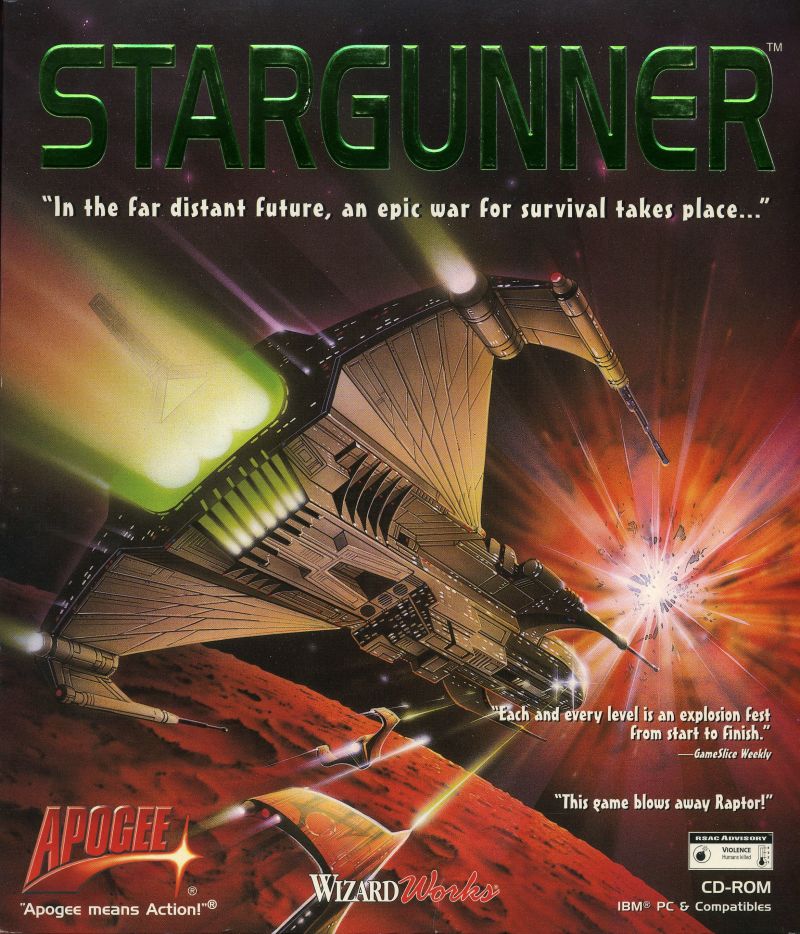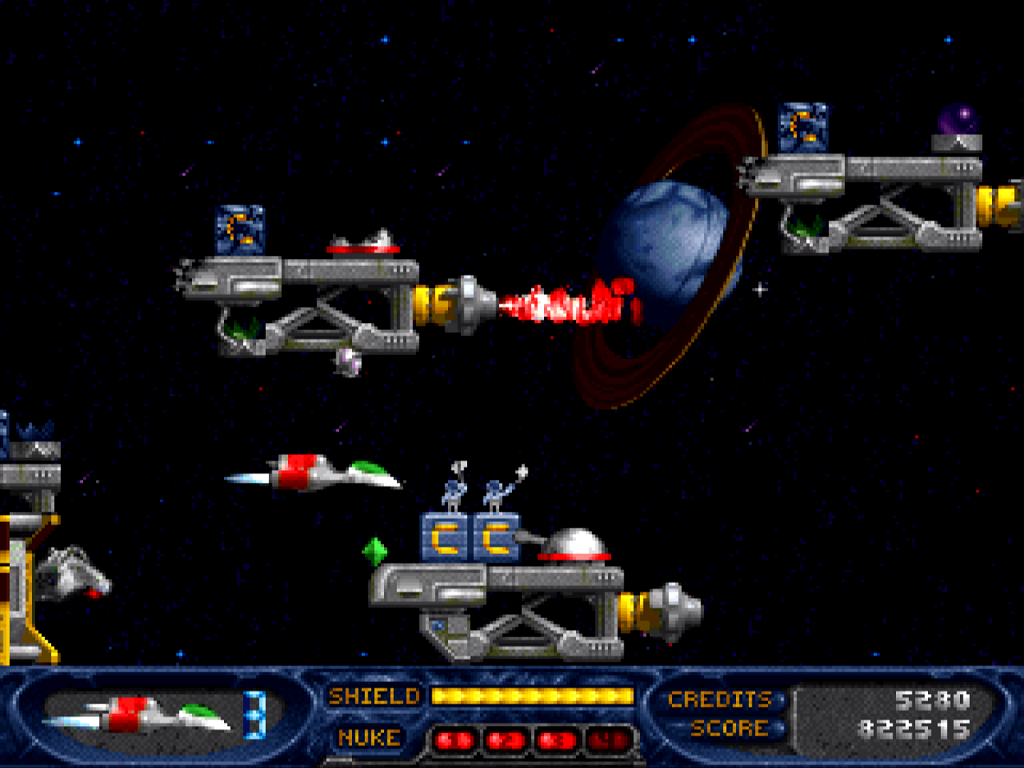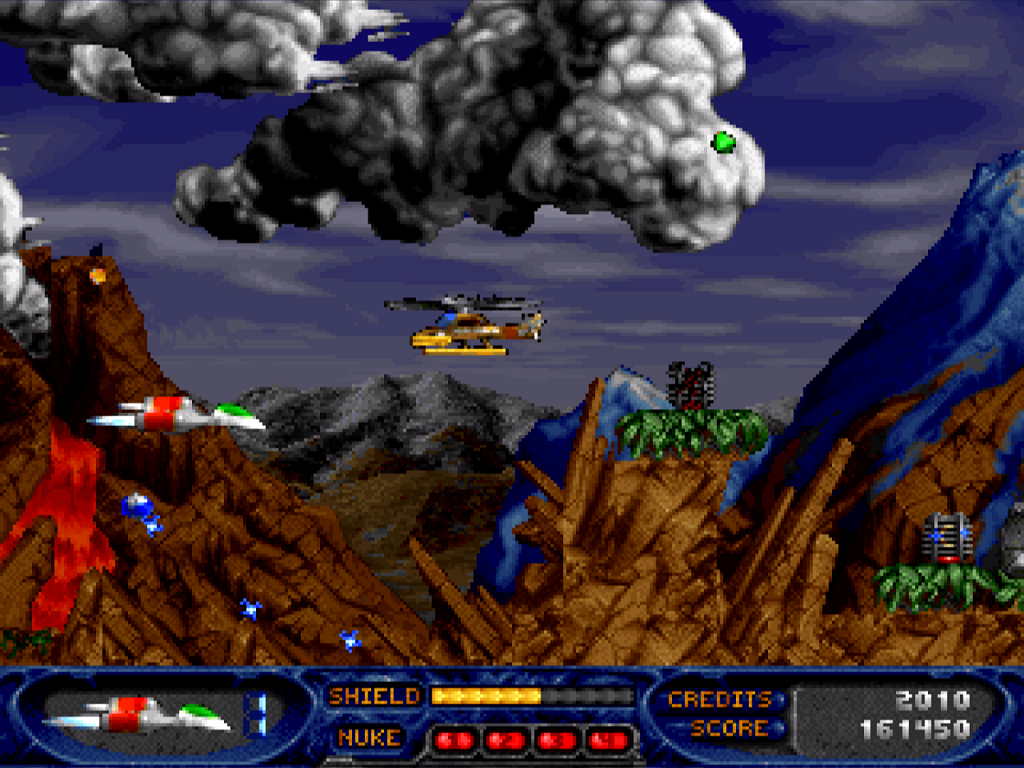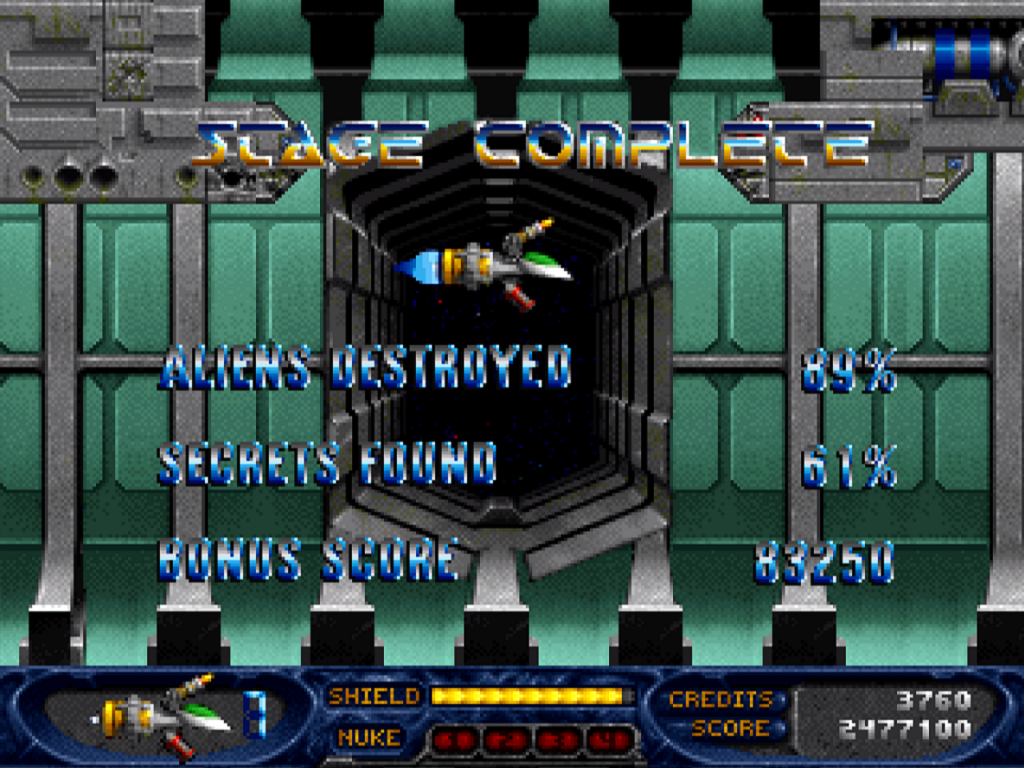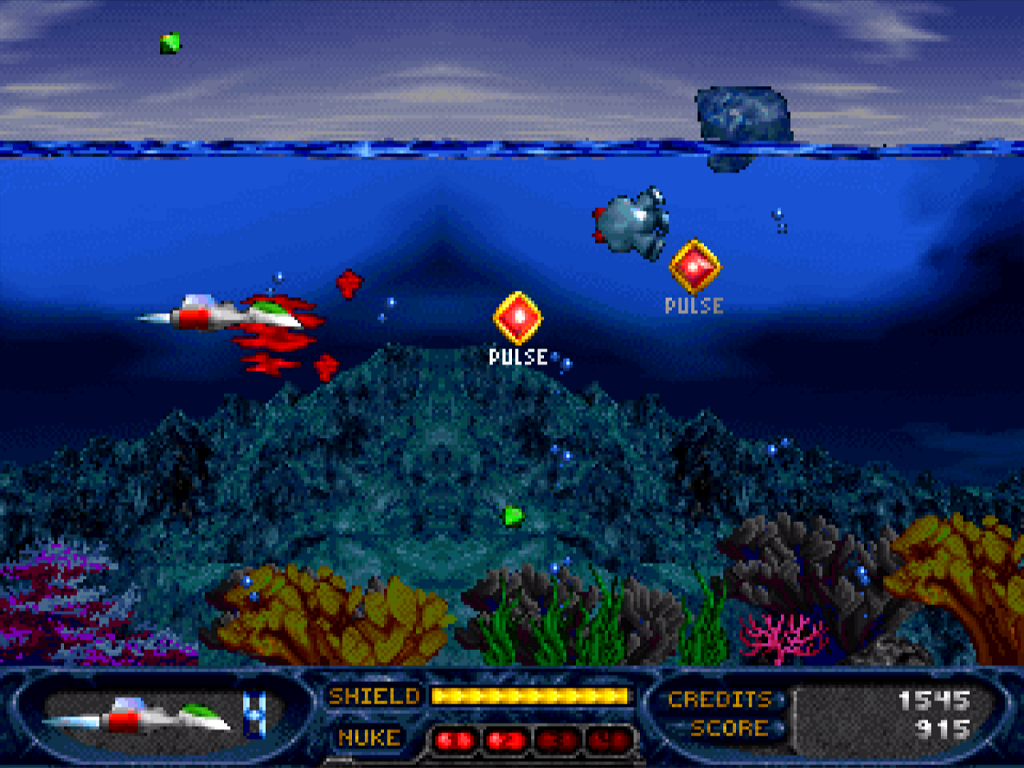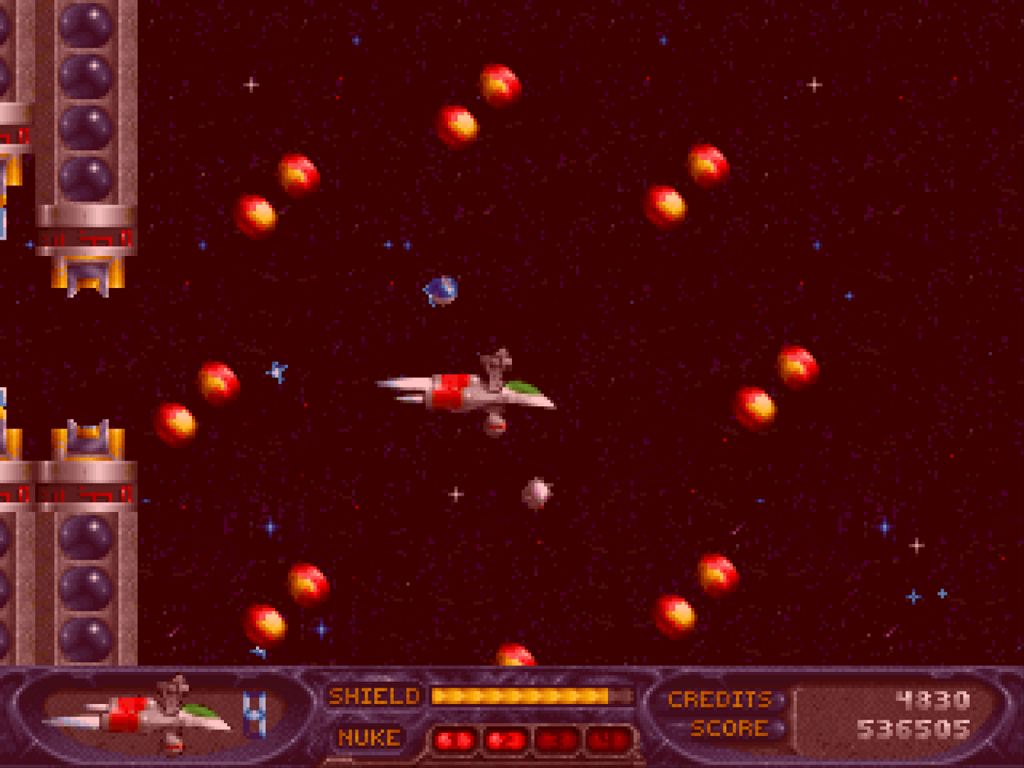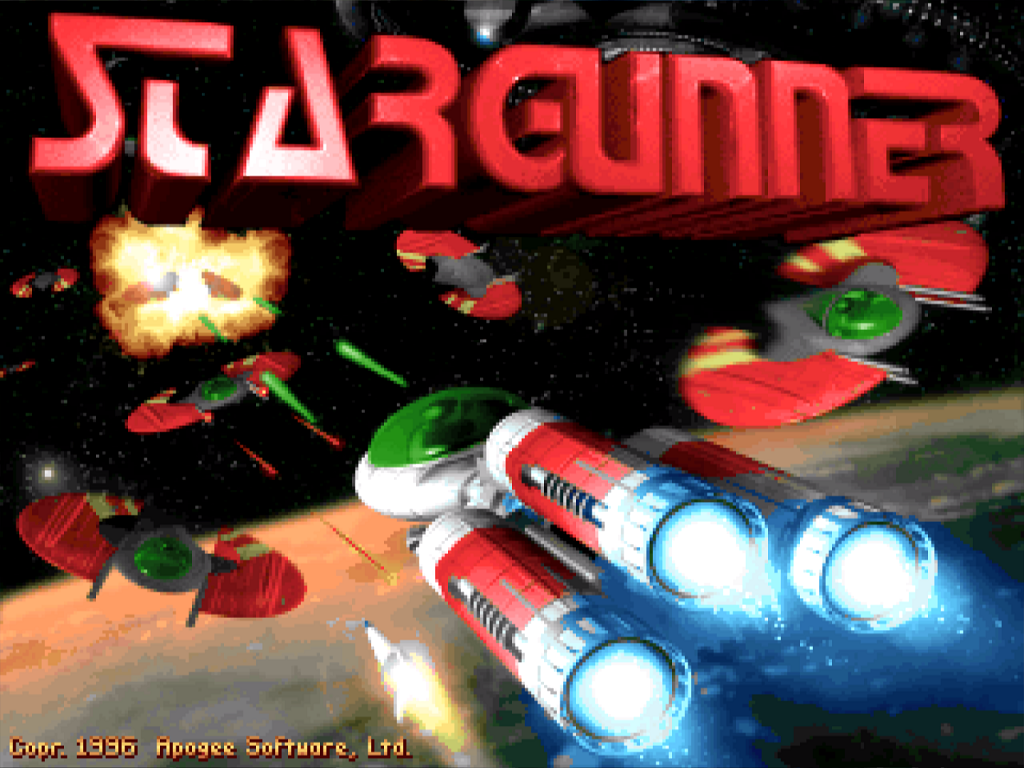STARGUNNER (PC)
Some good news to kick things off: Stargunner is freeware. What’s more, it can be tracked down easily on the usual PC gaming platforms, where it’s ready to go on modern operating systems. So, it isn’t a question of whether this scrolling shoot ‘em up is worthy of your money, but whether its worthy of your time and attention. If you’re a committed fan of side-scrolling blasters, then it’s a qualified ‘yes’: but only if you’re hankering desperately for mid-nineties shooters and have exhausted all other avenues.
Originally planned as an Amiga title during the autumn of the 16-bit computer’s life, priorities likely changed in tandem with the software market, leaving an MS-DOS release in late 1996 as Stargunner’s sole port of call. This horizontal-scrolling shoot ‘em up’s origins are belied instantly by its visuals. By the time of its release, many similar shooters were making moves to embrace polygons and pseudo-3D environments, and there’s no question Apogee’s effort looks dated and unremarkable. With one or two notable exceptions, the levels look drab and run-of-the-mill next to the more exciting 16-bit shooters.
Rescuing astronauts grants a points bonus: be careful not to shoot them first, in all the excitement
Coming complete with all four campaigns (three of which were originally positioned as mail-order additions, an early and unwelcome example of episodic content), there’s a whopping 34 levels to blast through… That is, 34 levels if you’re very, very good and very, very patient. Realistically, most players will be doing well to experience half of these, even on the easiest of the three skill settings. For the most part, the levels play quite nicely, though extended play reveals a disappointing lack of design evolution through each campaign, and foes that have an irritating habit of dive-bombing the player rather than shooting. There are more than seventy enemy-types to blast, as well as scenery to dodge and asteroid fields to navigate. There’s a trove of hidden power-ups to uncover around little crooks and gaps within the stages, emphasising rewards for replaying levels.
Stargunner’s sole standout feature is its ship customisation, which allows you to tinker with the setup via an intuitive end-of-level shop. Accumulated credits can be spent on a range of useful additions. These include a trio of engines, which grant greater manoeuvrability. There’s a tremendous range of weapons, of which two can be fitted at any one time. These vary considerably in terms of characteristics and usefulness and include short-range flamethrowers, missile launchers, cannons and lasers. It’s great fun trying out different combinations. In addition, you can enlist the help of two drones to orbit your ship, and these too have a number of uses, from lending a bit of close-quarters protection, to mopping up credits scattered about the levels. The only slight misstep is the exorbitant cost of extra lives which, standing at a whopping 4,000 credits each, are as expensive as some of the high-end weapons. Considering how easy it is to lose lives, the cost to buy one will likely forfeit the opportunity to purchase other upgrades, leaving you doomed either way.
Stargunner’s sole standout feature is its ship customisation, which allows you to tinker with the setup via an intuitive end-of-level shop. Accumulated credits can be spent on a range of useful additions. These include a trio of engines, which grant greater manoeuvrability. There’s a tremendous range of weapons, of which two can be fitted at any one time. These vary considerably in terms of characteristics and usefulness and include short-range flamethrowers, missile launchers, cannons and lasers. It’s great fun trying out different combinations. In addition, you can enlist the help of two drones to orbit your ship, and these too have a number of uses, from lending a bit of close-quarters protection, to mopping up credits scattered about the levels. The only slight misstep is the exorbitant cost of extra lives which, standing at a whopping 4,000 credits each, are as expensive as some of the high-end weapons. Considering how easy it is to lose lives, the cost to buy one will likely forfeit the opportunity to purchase other upgrades, leaving you doomed either way.
Stargunner could never be accused of being a trailblazer, but what it does, it does pretty well. Shooting is smooth as a steady stream of enemies assail the player and as you’d expect, there are lots of tricky, if rather unoriginal, bosses. Chasing high-scores offers fair incentive for fans of the genre. The first two campaigns encompass some well-worn space/sci-fi settings, and this is where the game is at its most playable. The other two are, thematically at least, a little more adventurous. One is set amidst Earth’s skies whilst the other, in a nod to Darius, takes the action beneath the waves for a subterranean campaign. Visually, this is easily the most distinctive part of the package, but also the least playable, with an increasingly unmanageable number of enemies, mines and explosive barrels populating the screen and seeing things descend into farce. Much of the game’s troubles stem from its unforgiving nature and harsh difficulty.
I know what you’re thinking: it’s a side-scrolling shoot ‘em up, it’s meant to be tough! I choose the word ‘harsh’ to be as specific as possible, however. Deaths often feel unfair. Against the run of play, if you will. You may carve through a few levels, losing no lives and shrewdly spending credits on bolstering firepower. It’s amazing how quickly good work can be undone, however. Enemies often spawn from behind, resulting in instant-deaths by collision. Bosses can be a horror show too, one level seeing you tackling three ships simultaneously. Each can destroy the player with a speedy blast of laser. When they’re not destroying you with firepower, they’re making use of a speed and size advantage to pull kamikaze attacks, their ships acting as the weapon. That’s an instant-death, too, and a highly unsatisfactory one at that. The Aquatic mission is especially nightmarish. Cheap deaths galore, it is possible to lose a life and then die again in the space of around one second.
I know what you’re thinking: it’s a side-scrolling shoot ‘em up, it’s meant to be tough! I choose the word ‘harsh’ to be as specific as possible, however. Deaths often feel unfair. Against the run of play, if you will. You may carve through a few levels, losing no lives and shrewdly spending credits on bolstering firepower. It’s amazing how quickly good work can be undone, however. Enemies often spawn from behind, resulting in instant-deaths by collision. Bosses can be a horror show too, one level seeing you tackling three ships simultaneously. Each can destroy the player with a speedy blast of laser. When they’re not destroying you with firepower, they’re making use of a speed and size advantage to pull kamikaze attacks, their ships acting as the weapon. That’s an instant-death, too, and a highly unsatisfactory one at that. The Aquatic mission is especially nightmarish. Cheap deaths galore, it is possible to lose a life and then die again in the space of around one second.
Cheap deaths and uninspired design means Stargunner struggles to distinguish itself, despite some solid score-attack potential
The music is bad, the effects forgettable, the voicing naff and inessential. Five lives with no continues means you’ll be getting to know the punishing, ceaseless enemy attack patterns of each campaign’s first few levels very well indeed. There’s no getting away from the fact that, whilst Stargunner is a serviceable shoot ‘em up with a lot of content, it compares poorly to other shooters, because it doesn’t have its own style or selling point. Everything on show here has been done to a better standard, in some cases, several years earlier. Whether your allegiance lies with the Thunder Force games, Gradius or a more left-field choice such as Gate of Thunder, they’re all far more playable than Stargunner. Apogee’s effort is now little more than space debris, left drifting with nothing to distinguish itself amongst superior competition.
